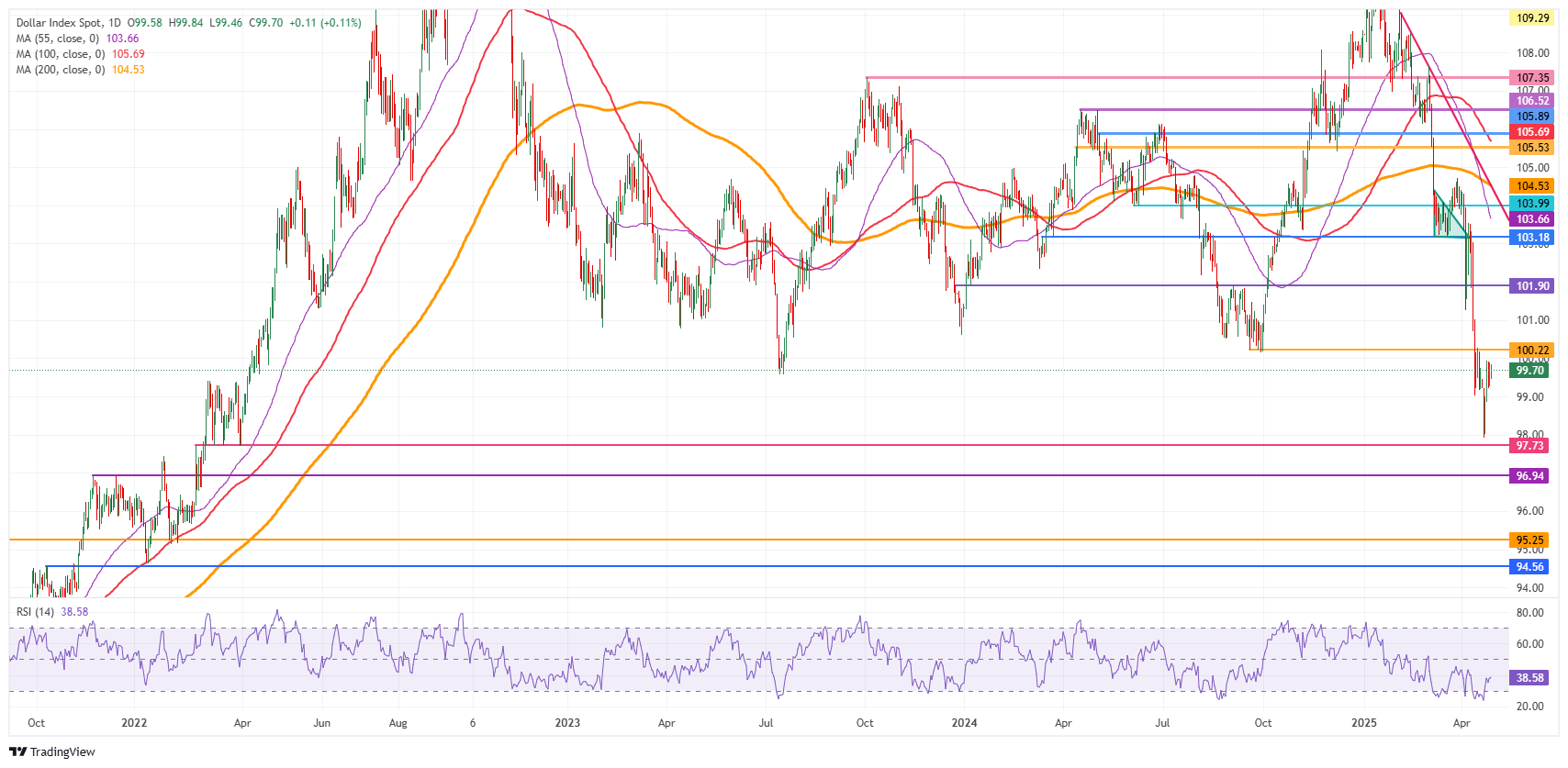- The US Dollar flatlines while traders keep calm ahead of a pivotal week in US data.
- Over the weekend, the Trump administration kept repeating talks with China on trade, China keeps dismissing US claims.
- The US Dollar Index remains capped below the 100.00 round level.
The US Dollar Index (DXY), which tracks the performance of the US Dollar (USD) against six major currencies, trades broadly flat on Monday just below the 100.00-marker. Over the weekend, United States (US) Treasury Secretary Scott Bessent said trade deal negotiations with several Asian countries are underway, while US Agriculture Secretary Brooke Rollins added that the Trump administration is having “daily conversations” with China over tariffs.
However, China said on Monday that it is not engaged in trade negotiations with the US. The country reiterated that there are no winners in a tariff trade war and that the US should talk on a basis of mutual respect, Bloomberg reported. In a spillover effect, retailers Temu and Shein lifted prices by as much as 300% for US consumers on its websites, Reuters reports.
On the economic calendar front, a very packed week is ahead. The data will likely help traders assess if the Federal Reserve (Fed) will deliver an interest-rate cut in its upcoming policy meeting on May 7. The main attention this week will be on Wednesday, with the first reading of the US Gross Domestic Product (GDP) for the first quarter. Next, on Friday, the US Employment report for April – which includes the all-important Nonfarm Payrolls number – is the main event to close off the week.
Daily digest market movers: Nothing new besides the usual rumors
- The Trump administration over the weekend has commented repeatedly that it is in talks with China on a trade deal. China said on Monday it is certainly not in any trade talks, Bloomberg reports.
- The US economic calendar is light on Monday. At 14:30 GMT, the Dallas Fed Manufacturing Business Index for April is due. No forecast available with the previous reading at -16.3.
- There are no scheduled Federal Reserve speakers this week as the blackout period has started ahead of the Federal Open Market Committee (FOMC) meeting and rate decision on May 7.
- Equities trade mixed this Monday. The only outlier was the Japanese Topix, which closed nearly 1% up. European equities are broadly positive, while US futures look rather sluggish.
- The CME FedWatch tool shows the chance of an interest rate cut by the Federal Reserve in May’s meeting stands at 8.9% against a 91.1% probability of no change. The June meeting has around a 61.9% chance of a rate cut.
- The US 10-year yields trade around 4.28%, looking for direction at the calm start the week.
US Dollar Index Technical Analysis: In range for now
The US Dollar Index (DXY) is not going anywhere as traders are keeping their powder dry for the US data later this week and amid constant woes over whether the US and China are in talks about trade.
On the upside, the DXY’s first resistance comes in at 100.22, which supported the DXY back in September 2024, with a break back above the 100.00 round level as a bullish signal. A firm recovery would be a return to 101.90, which acted as pivotal level throughout December 2023 and again as base for the inverted head-and-shoulders formation during the summer of 2024.
On the other hand, the 97.73 support could quickly be tested on any substantial bearish headline. Further below, a relatively thin technical support comes in at 96.94 before looking at the lower levels of this new price range. These would be at 95.25 and 94.56, meaning fresh lows not seen since 2022.

US Dollar Index: Daily Chart
Tariffs FAQs
Tariffs are customs duties levied on certain merchandise imports or a category of products. Tariffs are designed to help local producers and manufacturers be more competitive in the market by providing a price advantage over similar goods that can be imported. Tariffs are widely used as tools of protectionism, along with trade barriers and import quotas.
Although tariffs and taxes both generate government revenue to fund public goods and services, they have several distinctions. Tariffs are prepaid at the port of entry, while taxes are paid at the time of purchase. Taxes are imposed on individual taxpayers and businesses, while tariffs are paid by importers.
There are two schools of thought among economists regarding the usage of tariffs. While some argue that tariffs are necessary to protect domestic industries and address trade imbalances, others see them as a harmful tool that could potentially drive prices higher over the long term and lead to a damaging trade war by encouraging tit-for-tat tariffs.
During the run-up to the presidential election in November 2024, Donald Trump made it clear that he intends to use tariffs to support the US economy and American producers. In 2024, Mexico, China and Canada accounted for 42% of total US imports. In this period, Mexico stood out as the top exporter with $466.6 billion, according to the US Census Bureau. Hence, Trump wants to focus on these three nations when imposing tariffs. He also plans to use the revenue generated through tariffs to lower personal income taxes.

